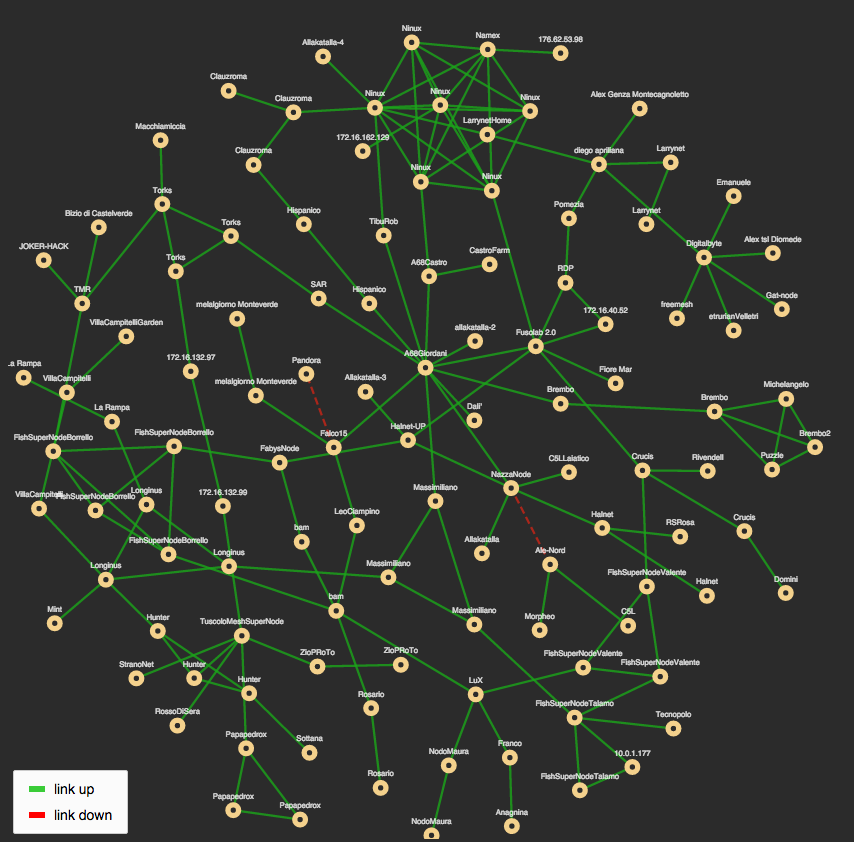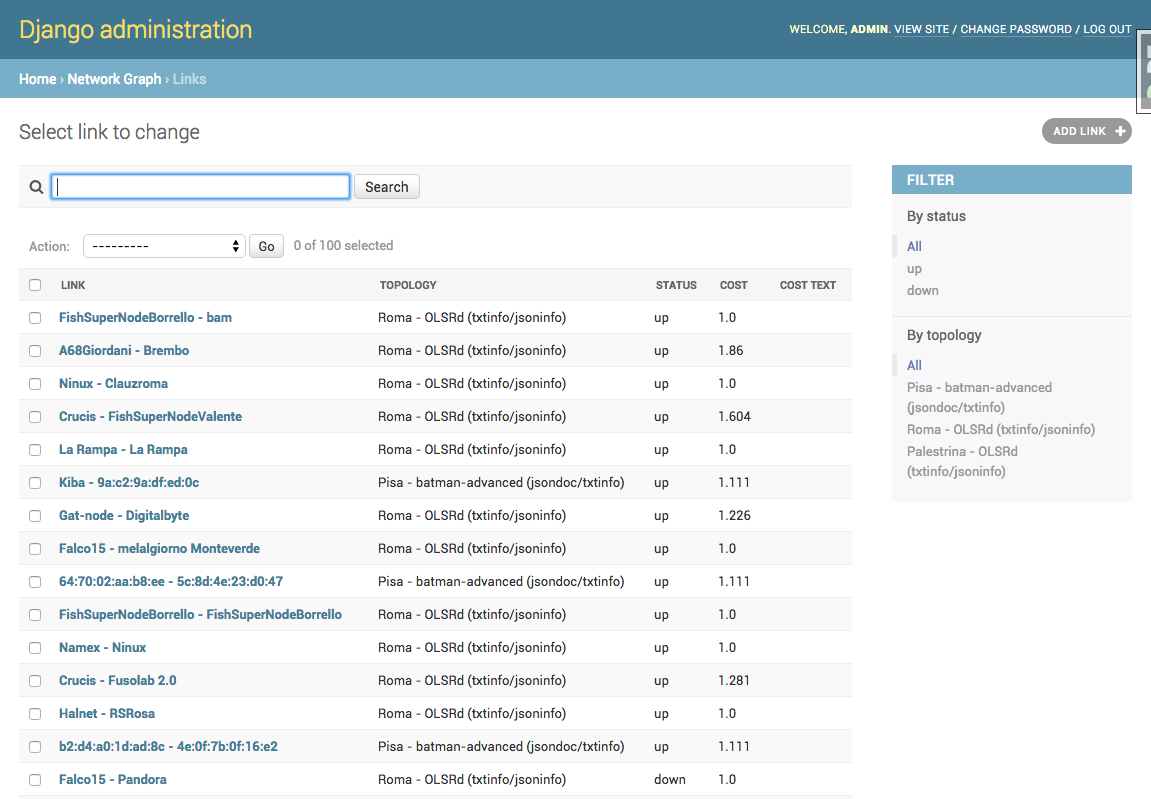Django implementation of NetJSON NetworkGraph
Project description





Reusable django app for collecting and visualizing network topology.


Current features
- network topology collector supporting different formats:
NetJSON NetworkGraph
OLSR (jsoninfo/txtinfo)
batman-adv (jsondoc/txtinfo)
BMX6 (q6m)
CNML 1.0
network topology visualizer based on netjsongraph.js
simple HTTP API that exposes data in NetJSON NetworkGraph format
admin interface that allows to easily manage, audit and debug topologies and their relative data (nodes, links)
Project goals
make it easy to visualize network topology data for the formats supported by netdiff
expose topology data via RESTful resources in NetJSON NetworkGraph format
make it easy to integrate in larger django projects to improve reusability
make it easy to extend its models by providing abstract models (needs improvement in this point)
provide ways to customize or replace the visualizer (needs improvement in this point)
keep the core very simple
provide ways to extend the default behaviour
encourage new features to be published as extensions
Install stable version from pypi
Install from pypi:
pip install django-netjsongraphInstall development version
Install tarball:
pip install https://github.com/interop-dev/django-netjsongraph/tarball/masterAlternatively you can install via pip using git:
pip install -e git+git://github.com/interop-dev/django-netjsongraph#egg=django-netjsongraphIf you want to contribute, install your cloned fork:
git clone git@github.com:<your_fork>/django-netjsongraph.git
cd django-netjsongraph
python setup.py developSetup (integrate in an existing django project)
Add rest_framework and django_netjsongraph to INSTALLED_APPS:
INSTALLED_APPS = [
# other apps
'rest_framework',
'django_netjsongraph'
# ...
]Include urls in your urlconf (you can change the prefixes according to your needs):
from django.conf.urls import include, url
from django_netjsongraph.api import urls as netjsongraph_api
from django_netjsongraph.visualizer import urls as netjsongraph_visualizer
urlpatterns = [
# your URLs ...
url(r'^api/', include(netjsongraph_api)),
url(r'', include(netjsongraph_visualizer)),
]Management Commands
update_topology
After topology URLs (URLs exposing the files that the topology of the network) have been added in the admin, the update_topology management command can be used to collect data and start playing with the network graph:
./manage.py update_topology
The management command accepts a --label argument that will be used to search in topology labels, eg:
./manage.py update_topology --label mytopology
Logging
The update_topology management command will automatically try to log errors.
For a good default LOGGING configuration refer to the test settings.
Settings
Setting |
Default value |
Description |
|---|---|---|
NETJSONGRAPH_PARSERS |
[] |
List with additional custom netdiff parsers |
NETJSONGRAPH_SIGNALS |
None |
String representing python module to import on initialization. Useful for loading django signals or to define custom behaviour. |
NETJSONGRAPH_TIMEOUT |
8 |
Timeout when requesting topology URLs |
NETJSONGRAPH_LINK_EXPIRATION |
60 |
If a link is down for more days than this number, it will be deleted by the update_topology management command. Setting this to False will disable this feature. |
Installing for development
Install sqlite:
sudo apt-get install sqlite3 libsqlite3-devInstall your forked repo:
git clone git://github.com/<your_fork>/django-netjsongraph
cd django-netjsongraph/
python setup.py developInstall test requirements:
pip install -r requirements-test.txtCreate database:
cd tests/
./manage.py migrate
./manage.py createsuperuserLaunch development server:
./manage.py runserverYou can access the visualizer at http://127.0.0.1:8000/ and the admin interface at http://127.0.0.1:8000/admin/.
Run tests with:
./runtests.pyContributing
First off, thanks for taking the time to read these guidelines.
Trying to follow these guidelines is important in order to minimize waste and avoid misunderstandings.
Ensure your changes meet the Project Goals
If you found a bug please send a failing test with a patch
If you want to add a new feature, announce your intentions in the issue tracker
Fork this repo and install it by following the instructions in Installing for development
Write code
Write tests for your code
Ensure all tests pass
Ensure test coverage is not under 90%
Document your changes
Send pull request
Changelog
See CHANGES.
License
See LICENSE.
Project details
Release history Release notifications | RSS feed
Download files
Download the file for your platform. If you're not sure which to choose, learn more about installing packages.
Source Distribution
Built Distribution
Hashes for django-netjsongraph-0.1.2.tar.gz
| Algorithm | Hash digest | |
|---|---|---|
| SHA256 | c2cd46d1440c583c521fe43e2eb82fbe682440a01cdcf600649b003cd0e5d0d1 |
|
| MD5 | 119c9bb07eaa3dafe17a974aeeca9a13 |
|
| BLAKE2b-256 | b9a0ac52a0cf56295f4873be613c4451dc8d12b78e6829364792e1d22b4420c1 |
Hashes for django_netjsongraph-0.1.2-py2.py3-none-any.whl
| Algorithm | Hash digest | |
|---|---|---|
| SHA256 | e3375f7cce33c1f92d52a754fbd10266820687948b32eff4d4f5bab3f7222276 |
|
| MD5 | 7704817996a612ad6da3d6d8c047379c |
|
| BLAKE2b-256 | 19855472408d6f2eca5214af2cbd045f42815469862a640ab079c56963887b75 |













